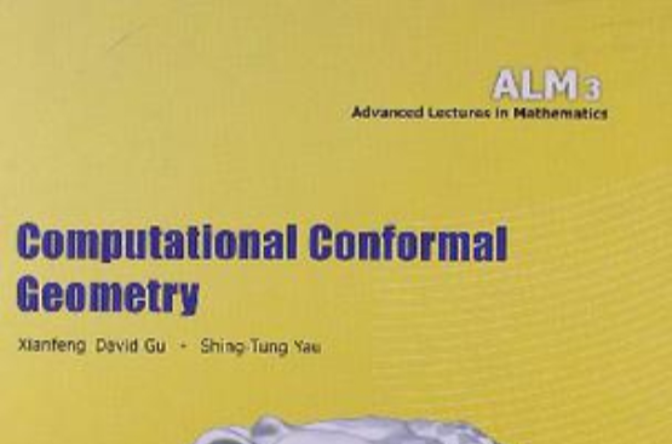《計算共形幾何》是2008年1月1日高等教育出版社出版的圖書,作者是顧險峰、丘成桐。
基本介紹
編輯推薦,內容簡介,目錄,
編輯推薦
《計算共形幾何》這個事實使得共形幾何方法在曲面匹配和比較中非常有價值.共形映射保持局部形狀,因此在可視化方面有很好的套用.所有的曲面都可以根據共形結構進行分類,而且所有的共形等價類形成一個有限維流形.這個流形有豐富的幾何結構,容易對其分析和研究.與之相反,曲面的等距類形成一個難以分析處理的無窮維流形.計算共形幾何算法是以橢圓偏微分方程為基礎的,而橢圓偏微分方程又是容易求解而且穩定的,因此計算共形幾何方法對於實際工程套用非常有用.共形幾何中,所有單連通曲面都能共形變換成某種標準空間:球面、平面、雙曲空間.也就是說,任何曲面都具有三種標準幾何(球幾何、歐式幾何、雙曲幾何)中的一種.這樣大部分三維數字幾何處理任務都能轉化成二維標準空間中的任務,共形幾何是純數學中很多學科的交叉領域,比如黎曼曲面理論、微分幾何、代數曲線、代數拓撲、偏微分方程、複分析等等.它有很長的歷史,至今在現代幾何與現代物理中仍然非常活躍.比如超弦理論中的共形場和理論物理中的模空間理論都是當今快速發展的研究領域.近些年來,隨著三維數字掃瞄器、計算機輔助幾何設計、生物信息和醫學成像的快速發展,出現了越來越多的三維數字模型.因此迫切需要有效的算法來表示、處理和使用這些模型.計算共形幾何在數字幾何處理中扮演了一個重要角色.它已經套用在很多重要的領域,比如曲面修復、光順、去噪、分片、特徵提取、註冊、重新格線化、格線樣條轉換、動畫和紋理合成.特別地,共形幾何奠定了曲面參數化的理論基礎,同時也提供了嚴格的算法.計算共形幾何還套用於計算機視覺中的人臉跟蹤、識別和表情轉換,醫學成像中的腦電圖、虛擬結腸鏡和數據融合,幾何建模中的具有任意拓撲流形上的樣條構造.
共形幾何之所以如此有用是基於以下一些事實:
共形幾何研究的是共形結構.日常生活中的所有曲面都有一個自然的共形結構,因此共形幾何算法非常普遍.共形結構比黎曼度量結構更靈活、比拓撲結構更具有剛性.它能處理大量黎曼幾何不能有效處理的變換,這些變換還能保持很多拓撲方法會丟失的幾何信息.共形映射比較容易控制.比如,兩個單連通封閉曲面之間的共形映射構成一個6維空間,因此只要固定3個點,。
內容簡介
Computational conformal geometry is an emerging inter- disciplinary field, which appliesalgebraic topology, differential geometry and Riemann surface theories in geometricmodeling, computer graphics, computer vision, medical imaging, visualization, scientificcomputation and many other engineering fields. This textbook is the first one to thoroughlyintroduce both theoretical foundations and practical algorithms of Computational conformalgeometry, which have the direct applications in engineering and digital geometricprocessing, such as surface parameterization, surface matching, brain mapping, 3D facerecognition and identification, facial expression animation, dynamic face tracking, mesh-spline conversion and so on.
目錄
Introduction
1.1 Overview of Theories
1.1.1 RiemannMapping
1.1.2 Riemann Uniformization
1.1.3 Shape Space
1.1.4 General Geometric Structure
1.2 Algorithms for Computing Conformal Mappings
1.3 Applications
1.3.1 Computer Graphics
1.3.2 Computer Vision
1.3.3 Geometric Modeling
1.3.4 Medical Imaging
Further Readings
Part I Theories
Homotopy Group
2.1 Algebraic Topological Methodology
2.2 Surface Topological Classification
2.3 Homotopy of Continuous Mappings
2.4 Homotopy Group
2.5 Homotopy Invariant
2.6 Covering Spaces
2.7 Group Representation
2.8 Seifert-van Kampen Theorem
Problems
Homology and Cohomology
3.1 Simplicial Homology
3.1.1 Simplicial Complex
3.1.2 Geometric Approximation Accuracy
3.1.3 Chain Complex
3.1.4 Chain Map and Induced Homomorphism
3.1.5 Simplicial Map
3.1.6 Chain Homotopy
3.1.7 Homotopy Equivalence
3.1.8 Relation Between Homology Group and Homotopy Grou
3.1.9 Lefschetz Fixed Point
3.1.10 Mayer-Vietoris Homology Sequence
3.1.11 Tunnel Loop and Handle Loop
3.2 Cohomology
3.2.1 Cohomology Group
3.2.2 Cochain Map
3.2.3 Cochain Homotopy
Problems
4 Exterior Differential Calculus
4.1 Smooth Manifold
4.2 Differential Forms
4.3 Integration
4.4 Exterior Derivative and Stokes Theorem
4.5 De Rham Cohomology Group
4.6 Harmonic Forms
4.7 Hodge Theorem
Problems
5 Differential Geometry of Surfaces
5.1 Curve Theory
5.2 Local Theory of Surfaces
5.2.1 Regular Surface
5.2.2 First Fundamental Form
5.2.3 Second Fundamental Form
5.2.4 Weingarten Transformation
5.3 Orthonormal Movable Frame
5.3.1 Structure Equation
5.4 Covariant Differentiation
5.4.1 Geodesic Curvature
5.5 Gauss-Bonnet Theorem
5.6 Index Theorem of Tangent Vector Field
5.7 Minimal Surface
5.7.1 Weierstrass Representation
5.7.2 Costa Minimal Surface
Problems
Riemann Surface
6.1 Riemann Surface
6.2 Riemann Mapping Theorem
6.2.1 Conformal Module
6.2.2 Quasi-Conformal Mapping
6.2.3 Holomorphic Mappings
6.3 Holomorphic One-Forms
6.4 Period Matrix
6.5 Riemann-Roch Theorem
6.6 Abel Theorem
6.7 Uniformization
6.8 Hyperbolic Riemann Surface
6.9 Teichmiiller Space
6.9.1 Quasi-Conformal Map
6.9.2 Extremal Quasi-Conformal Map
6.10 Teichm011er Space and Modular Space
6.10.1 Fricke Space Model
6.10.2 Geodesic Spectrum
Problems
Harmonic Maps and Surface Ricci Flow
7.1 Harmonic Maps of Surfaces
7.1.1 Harmonic Energy and Harmonic Maps
7.1.2 Harmonic Map Equation
7.1.3 Rad6's Theorem
7.1.4 Hopf Differential
7.1.5 Complex Form
7.1.6 Bochner Formula
7.1.7 Existence and Regularity
7.1.8 Uniqueness
7.2 Surface Ricci Flow
7.2.1 Conformal Deformation
7.2.2 Surface Ricci Flow
Problems
Geometric Structure
8.1 (X, G) Geometric Structure
8.2 Development and Holonomy
8.3 Affine Structures on Surfaces
8.4 Spherical Structure
8.5 Euclidean Structure
8.6 Hyperbolic Structure
8.7 Real Projective Structure
Problems
Part II Algorithms
Topological Algorithms
9.1 Triangular Meshes
9.1.1 Half-Edge Data Structure
9.1.2 Code Samples
9.2 Cut Graph
9.3 Fundamental Domain
9.4 Basis of Homotopy Group
9.5 Gluing Two Meshes
9.6 Universal Covering Space
9.7 Curve Lifting
9.8 Homotopy Detection
9.9 The Shortest Loop
9.10 Canonical Homotopy Group Generator
Further Readings
Problems
10 Algorithms for Harmonic Maps
10.1 Piecewise Linear Functional Space, Inner Product and Laplacian
10.2 Newton's Method for Open Surface
10.3 Non-Linear Heat Diffusion for Closed Surfaces
10.4 Riemann Mapping
10.5 Least Square Method for Solving Beltrami Equation
10.6 General Surface Mapping
Further Readings
Problems
11 Harmonic Forms and Holomorphic Forms
11.1 Characteristic Forms
11.2 Wedge Product
11.3 Characteristic 1-Form
11.4 Computing Cohomology Basis
l1.5 Harmonic 1-Form
11.6 Hodge Star Operator
11.7 Holomorphic 1-Form
11.8 Inner Product Among 1-Forms
11.9 Holomorphic Forms on Surfaces with Boundaries
11.10 Zero Points and Critical Trajectories
11.11 Flat Metric Induced by Holomorphic 1-Forms
11.12 Conformal Invariants
11.13 Conformal Mappings for Multi-Holed Annuli
Further Readings
Problems
12 Discrete Ricci Flow
12.1 Circle Packing Metric
12.2 Discrete Gaussian Curvature
12.3 Discrete Surface Ricci Flow
12.4 Newton's Method
12.5 Isometric Planar Embedding
12.6 Surfaces with Boundaries
12.7 Optimal Parameterization Using Ricci Flow
12.8 Hyperbolic Ricci Flow
12.9 Hyperbolic Embedding
12.9.1 Poincare Disk Model
12.9.2 Embedding the Fundamental Domain
12.9.3 Hyperbolic Embedding of the Universal Covering Space
12.10 Hyperbolic Ricci Flow for Surfaces with Boundaries
Further Readings
Problems
A Major Algorithms
B Acknowledgement
Reference
Index

